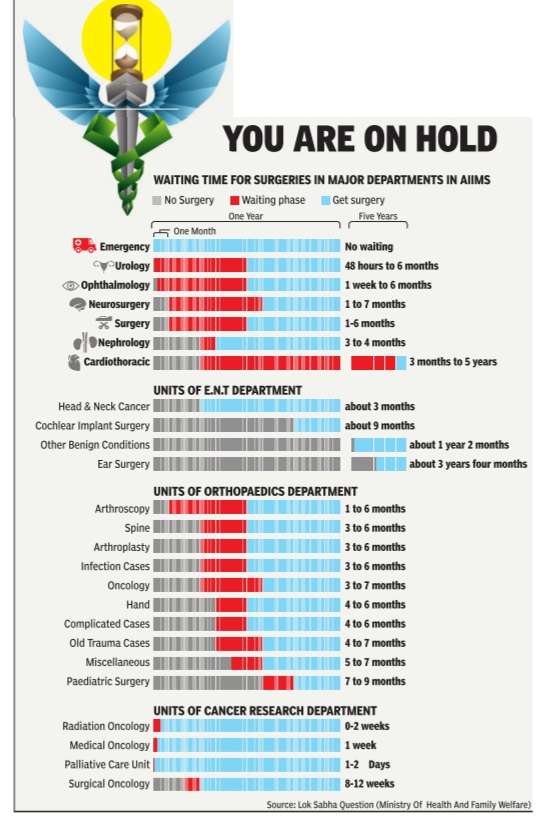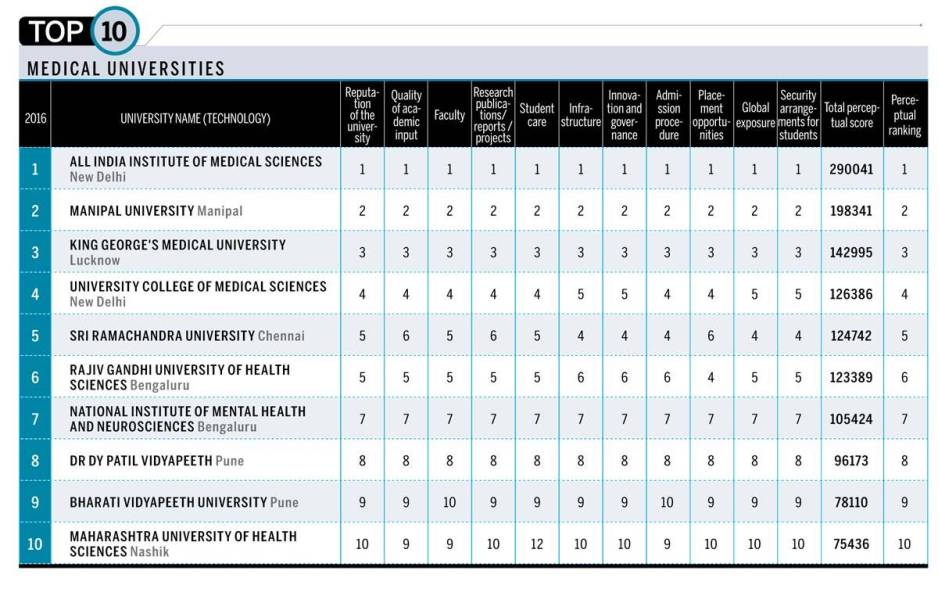All India Institute of Medical Sciences (AIIMS), Delhi
This is a collection of articles archived for the excellence of their content. |
Background
Source:
1. The Times of India, Dec 27 2014
2. India Today
The All India Institute of Medical Sciences, Delhi was established by the AIIMS Act of 1956. AIIMS was created to serve as a nucleus for nurturing excellence in all aspects of health care.The institute has comprehensive facilities for teaching, research and patient-care. Teaching and research are conducted in 42 disciplines.
For a long time, it remained the only medical institute of its kind in the country providing super-speciality care at an affordable cost. The act was amended in 2012 and six new AIIMS were established at other locations. The waiting period for surgery in various departments of AIIMS, Delhi shows the immense burden of patients on the institute. There is obviously no waiting period for emergency cases, but for some other cases it can stretch up to five years
Bone bank, cadaveric
1999-2017: only 24 donations
Just 24 donations at AIIMS bone bank in 18 years, May 22, 2017: The Times of India
One of India's first cadaveric bone banks started in 1999 in AIIMS remains a nonstarter. Officials say the bank has received just 24 cadaver donations in last 18 years.
More so, there has been no donation in the last two years. The donated bones can be used for replacing a lost segment of bone due to cancer, infection or injury . Also, it can be used to fill up cavities or holes left by major cancer surgeries, Dr Rajesh Malhotra, chief of AIIMS Trauma Centre and who had started the bank, said.
He said lack of knowledge coupled with misconceptions and religious sentiments are major reasons behind the failure of the programme.“Even after being set up in 1999, the first bone donation was not until 2001,“ he added.
People think that taking out bones will mutilate and disfigure the body and the limbs will dangle, the AIIMS doctor said, adding that it's not the case.
Once the bones are taken out, the body is reconstructed and the shape and structure of the limbs are restored by putting wooden sticks and stuffing it up with cotton and wool. Even knee caps are made with cotton and wool.
“So, after taking out the bones, which usually takes 10 minutes, we spend the next 30 minutes on stitching up the body so that aesthetically it looks good and the dignity of the donor is maintained.
“ All that the relatives of the deceased will be able to see is a stitch that is visible after surgery ,“ Malhotra explained. The cotton wool also absorbs any fluids oozing out and the body is not left in a puddle of blood after the procedure. Bones from cadavers have to be retrieved within 12 hours. If a body is refrigerated, then the time frame extends up to 38 hours. They are then tested for HIV , hepatitis or other infection.
If this procedure is followed and the bones then stored at -70 degrees Celsius, these can be preserved for around five years, Malhotra said.
Thousands of cancer and trauma patients need bone transplants in India every year, while only 35% of them get these. Bones can be donated by people even when they are alive, he said.
The Building
2020: new OPD block, Masjid Moth
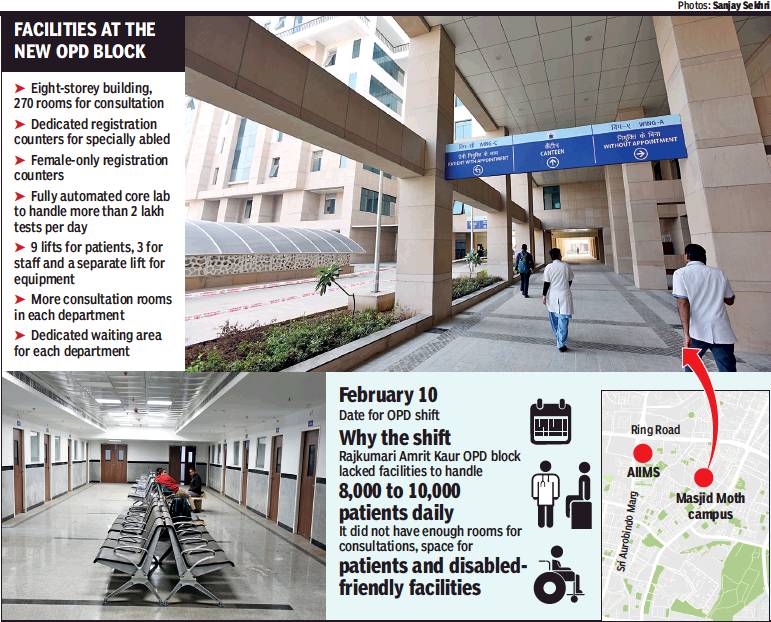
From: DurgeshNandan Jha, More facilities, less wait at new AIIMS OPD block, February 10, 2020: The Times of India
More than 50 years after its establishment, All India Institute of Medical Sciences (AIIMS) is all set to undergo the biggest infrastructural overhaul. The Raj Kumari Amrit Kaur OPD block on the main campus will be relocated to the new building at Masjid Moth, located about half a kilometre away from the main campus.
TOI recently visited the upcoming eight-storey facility where workers could be seen giving final touches and fixing the fitments.
“The old OPD block had outlived its utility. It wasn’t able to cope with the patient load. Therefore, the institute decided to build a new one. It is a truly modern building with disabled-friendly services, such as separate counters for the specially abled and a ramp for wheelchairs and trolleys, among others,” said Dr Arti Vij, chairman, media protocol division, AIIMS.
Vij added that the new block would be made operational in two phases. The first phase, starting February 10, will involve shifting of OPDs for general medicine, endocrinology and orthopaedics, among others. In the second phase, a fully-automated core lab with capacity to handle over two lakh tests daily will be made operational.
“There are nine lifts for patients in the new block, three for staff and one for equipment. Also, there is a queue management system, which will be enrolled in the second phase,” said another official.
Over 8,000 patients from across the country visit the AIIMS OPD daily. Currently, the OPD services are run from Raj Kumari Amrit Kaur OPD Block, which came up in 1950s. It is overcrowded and patients are often found squatting on the floor. The new block is designed to serve better, an official said.
“The new building will have a dedicated lab for OPD patients to increase the number of tests and decrease waiting time. It will also have a waiting area, minor operation theatres and resuscitation facilities on each floor,” said the official.
The doctors at the hospital said that shifting outpatient department services would help decongest the main hospital and allow for better management of inpatient facilities. “The existing OPD may be utilised to expand emergency medicine and other inpatient departments, depending on the need assessments,” said a senior doctor.
In addition to the OPD block, the Masjid Moth campus in south Delhi will also house the upcoming mother-and-child and surgical blocks. The authorities said both the buildings were ready and furnishing and equipment installation under way. All these projects, he added, were conceptualised long ago and the construction work started between 2014 and 2015.
2023: 7 new blocks
Anuja.Jaiswal, Dec 14, 2023: The Times of India
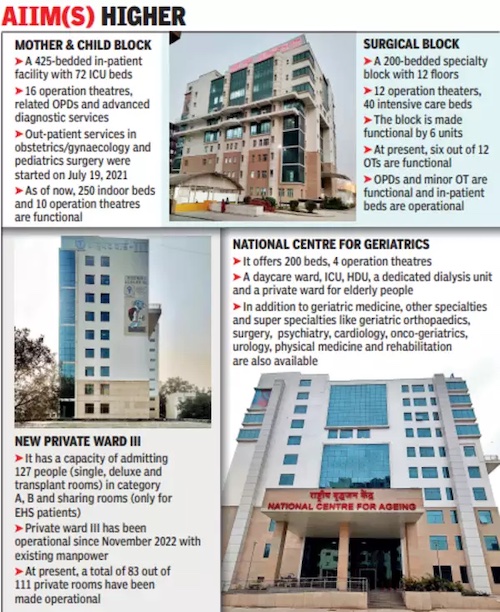
From: Anuja.Jaiswal, Dec 14, 2023: The Times of India
Promise of better facilities and reduced wait time with 7 special blocks at AIIMS
New Delhi : Union health minister Dr Mansukh Mandaviya formally inaugurated seven special blocks at AIIMS, dedicating the state-ofthe-art facilities to the nation.
The new facilities include the National Centre for Geriatrics; surgical block; mother and child block; private ward in the main hospital; the Centre for Advanced Research in Hospital Infection Control and Forensic DNA Laboratory at JPN Apex Trauma Centre; the Centre for Medical Innovation and Entrepreneurship (CMIE) and a private ward at National Cancer Institute (NCI), Jhajjar. All the blocks and centres had been earlier launched online. Dr Mandaviya praised AIIMS Delhi as “a lighthouse, setting conventions and principles that the entire country follows”. He said the new facilities were aimed at improving healthcare services for the common people, adding, “The objective is to ensure that access to quality and affordable healthcare reaches the last mile.”
According to AIIMS officials, with the addition of the new facilities, the institute aims to reduce waiting time for patients and expand its capacity to serve more people. The department of geriatric medicine, which has now been upgraded to the National Centre for Geriatrics, offers healthcare services for the elderly under one umbrella. In addition to geriatric medicine, other specialties and superspecialties, such as geriatric orthopaedics, surgery, psychiatry, cardiology, onco-geriatrics, urology, physical medicine and re habilitation, specialised dietetics services, homecare training for caregivers, counselling and diagnostic facilities are available to the beneficiaries under one roof. It offers 200 beds, four operation theatres, a daycare ward, an ICU and an HDU, adedicated dialysis unit and a private ward for the elderly.
Meanwhile, administrative officials said the private ward III of the main hospital was operationalised in November 2022 using existing manpower. As of now, 83 of 111 private rooms have been made operational with the given re sources. AIIMS is in the process of outsourcing the facility management services of private wards to significantly improve their quality and ensure an enhanced experience. Officials said the mother and child block has been developed to augment the infrastructure at AIIMS and accommodate three departments — obstetrics and gynaecology; paediatrics; and paediatric surgery plus allied departments, including diagnostics. As of now, 250 indoor beds and 10 OTs are functional. The fully operational block is expected to cater to 2,500 outpatients daily and 425 new admissions. The soft launch of the surgery block was done in December 2021. This block will help carry out additional surgeries and reduce the waiting time for critically-ill patients.
Currently, six out of 12 OTs are functional. To expand and diversify cancer care services for every section of the society, the private ward at NCI Jhajjar has been commissioned. Each room is air-conditioned and equipped with a bed with provision for oxygen supply and continuous monitoring. The room is also furnished with a refrigerator, TV, sofa and expandable attendant settee and Wi-Fi access, said officials. The forensic DNA laboratory at the institute’s trauma centre is the first-of-its-kind facility that will aid rapid identification of unknown/ unidentified bodies. The facility is being used to identify disaster victims based on DNA identification in cases of mass casualties. It had helped identify at least 80 victims of the Balasore train accident.
Disciplinary issues
2017/ Nurses take leave, Emergency shuts for 1st time
HIGHLIGHTS
Only around 400 senior staffers out of 5,400 nurses at the hospital reported for duty
AIIMS administration claimed that they had tried to persuade the nurses not go on mass leave
For the first time in the premier institution's history, emergency and OT services were completely shut down at AIIMS on Friday as nurses went on mass casual leave to press for increased allowances in the seventh pay commission.
Only around 400 senior staffers out of 5,400 nurses at the hospital reported for duty even as hundreds of critically-ill patients were denied admission in view of the staff crunch.
All planned surgeries and minor procedures had to be cancelled, officials said. More than 200 surgeries take place at the institute daily. "On Friday, only emergency cases could be taken up for surgery. We sought the help of senior paramedical staff and students for that," a senior doctor, who did not want to be quoted, said.
Friday's shutdown left many in tears."My uncle's condition is critical. But the gu ards are not allowing us to take him to the casualty ward. Where do we go now?" asked Nutan Verma, who had come from Tahirpur in east Delhi. Not a single patient was admitted to the casualty sections of AIIMS and its trauma centre. AIIMS's main casualty gets around 450 pa tients daily, many of them emergency cases requiring immediate medical attention.
Only those who got admission on Thursday were being treated by doctors. TOI found that the hospital staff utilised the opportunity to clean the main casualty .
At the trauma centre, which is the country's apex centre for emergency services and receives around 150 trauma patients daily , security guards had been deployed to tell patients to go elsewhere.
Initiatives
DNA database of the missing dead
February 9, 2022: The Times of India
Apilot project at AIIMS, under which DNA samples of all unidentified bodies brought to the hospital for postmortem are being stored, is helping families of people who have gone missing find closure, reports Durgesh Nandan Jha.
The project has helped identify several unclaimed bodies through DNA matches with family members who had contacted the hospital. Dr Chittaranjan Behera, the project’s principal investigator, said they aim to create similar DNA databases in all mortuaries in India.
Video-Clinic For OPD
DurgeshNandan Jha, Avoid AIIMS rush, consult doc via web, Nov 14 2016 : The Times of India
Video-Clinic Facility For OPD
Getting a second opinion from specialists at AIIMS or seeking their suggestions on post-operative care is now just a click away.
Patients can log in to the institute's website and put a request for video consultation, a feature added recently to the online OPD consultation system. Officials told TOI that the dry run of AIIMS video clinic has been completed successfully. Specialists from 20 departments, including medicine, gastroenterology and cardiology, have consented to taking out a couple of hours daily for the job, they added.
Dr Deepak Agrawal, who heads the IT division, said that this consultation will not be valid for medico-legal purposes as it will be given without the physical presence of the patient.
“The AIIMS video clinic has been developed by Natio nal Informatics Centre. It allows uploading of discharge summary and investigation reports. We will be deputing nurses trained in IT to coordinate with the doctors for video calls in the time allotted for each patient,“ Agrawal added.
The video-clinic facility is expected to help reduce patient burden, apart from easing the hardship and financial impact suffered by patients travelling from other states for a second opinion or treatment without prior appointment.
On an average, doctors sa id, close to 10,000 patients visit AIIMS daily . Of this, 50% are follow-up cases and 40% come for a second opinion. Only 10% are new cases. “Today , majority of specialist doctors are concentrated in metro cities. The use of such technology can help reduce the gap of specialists in small cities and villages as even the local doctors can use it to treat local patients,“ said another doctor.
The waiting period for neurosurgery or cancer treatment is up to a year. Experts say that telemedicine and video clinic can be an additional help, but focus is needed to improving existing public health facilities.
Research
Forearm created/ 2022
August 8, 2022: The Times of India
The AIIMS Delhi has achieved a new feat by becoming the first hospital in the country to successfully create a new forearm of a 27-yearold patient, reports Somrita Ghosh. With multiple levels of surgery, the whole process of getting a new forearm took three years to complete. In 2019 November, the left-hand dominant factory worker from Saharanpur came to the hospital with left forearm crushed by a hydraulic pressing machine. The plastic surgery team led by Dr Maneesh Singhal quickly assessed the patient's condition and decided to go ahead with reconstruction of the forearm.
Low Body Mass Index among Indian women
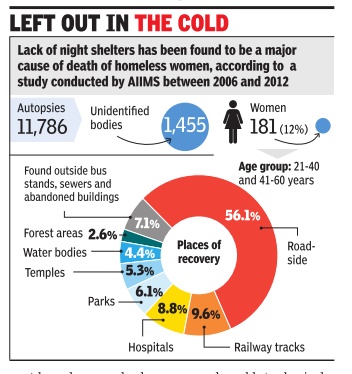
An analysis of postmortems conducted at AIIMS on unclaimed bodies of women from 2006 to 2012 has revealed that most of bodies had low Body Mass Index (BMI), indicating malnutrition along with superimposed diseases.
Nearly one in every three woman suffered from acute pneumonia, which doctors pointed out could be linked to lack of shelter facility during winter months.
“Self-neglect, poor personal hygiene and lack of access to medical facilities may further exacerbate the morbidity and mortality due to pneumonia,“ stated the study published by AIIMS in the latest issue of National Medical Journal of India (NMJI).
It added that accidents were the second most common cause of death. Most women suffered haemorrhagic shock andor severe head injury in road traffic accident leading to their death.“One explanation for road accident deaths could be that most homeless people sleep near roads and hence they are prone to accidents,“ Dr Chittaranjan Behera, the lead author told TOI. He added that homicidal and suicidal causes accounted for 11% and 8% of all deaths, respectively.
“Most homeless women are vulnerable to physical as well as sexual abuse, which makes them more prone to homicides,“ the doctor said, adding they came across a 25-year-old pregnant woman who had been strangulated and left to die.
The doctors, in their report on unclaimed bodies of women published in NMJI, advocated for increased sensitivity to be shown towards the vulnerable section of society , apart from creating safe shelter homes.
“Mental distress caused by extreme poverty and physical andor sexual abuse may account for most instances of suicide,“ the journal said.
Activists said that while the number of night shelters for homeless has gone up, safety and security of women living there needs further improvement. “There were few toilets. In some cases, the shelters meant for men and women lay adjacent to each other,“ said an activist. He added that recently Delhi government has come up with plans to open mohalla clinics near the night shelters so that the habitants can seek medical care.
According to a 2010 survey, the NMJI study said that nearly 56,000 people are estimated to be homeless in Delhi. Women constitute a minor proportion of the homeless but represent a more vulnerable and often neglected section.
Medical accomplishments, milestones
Heart transplants, 1994-2016
A new first at AIIMS: 50th heart transplant, Nov 02 2016 : The Times of India
13 Surgeries Performed This Year, 5 In 2015
In a milestone surgery , the All India Institute of Medical Sciences (AIIMS) performed its 50th successful heart transplant -a first for any public hospital in the country -on Diwali eve this year.
The institute was the first to conduct heart transplant in India in 1994, but the rate of surgeries went down in the following years due to lack of donors.However, the hospital authorities said that it has improved significantly over the last two years.
In 2015, the hospital conducted five successful heart transplants and this year, as on October 31, the hospital has transplanted hearts in 13 patients suffering from endstage failure of the organ.
“Two heart transplants have been conducted in the past week. A 42-year-old man from Rohtak was operated upon on Diwali eve, while another patient suffering from heart failure underwent the life-saving procedure on October 25. The donors in both cases were road accident victims,“ said a senior official. “We told the Rohtak man, who used to work as a DTC driver earlier, that the transplant was his Diwali gift from AIIMS,“ said Dr Sandeep Seth, professor of cardiology at AIIMS.
He said that the donor, a 35-year-old woman, weighed nearly as much as the recipient and their blood groups also matched, so there was no hurdle in the transplant.
According to Dr Balram Airan, professor of cardiothoracic and vascular surgery , who was part of the team which had performed the country's first heart transplant at AIIMS on August 3, 1994, about 350 heart transplants have been performed in India. “Maximum transplants have taken place in private hospitals. It is good that government hospitals -like ours, where the surgery is nearly free of cost -are also conducting them frequently,“ he added.
“Better coordination among local administration and air and road traffic agencies have helped improve the rate of donations and transplants,“ said Dr M C Misra, AIIMS director.
According to the medical institute, nearly 50,000 people are in immediate need of heart transplants in the country . Dr Seth said the survival rate in heart transplant cases is maximum of 17 years after the surgery .
Bikini hip replacement surgery/ 2021
DurgeshNandan Jha, August 27, 2021: The Times of India
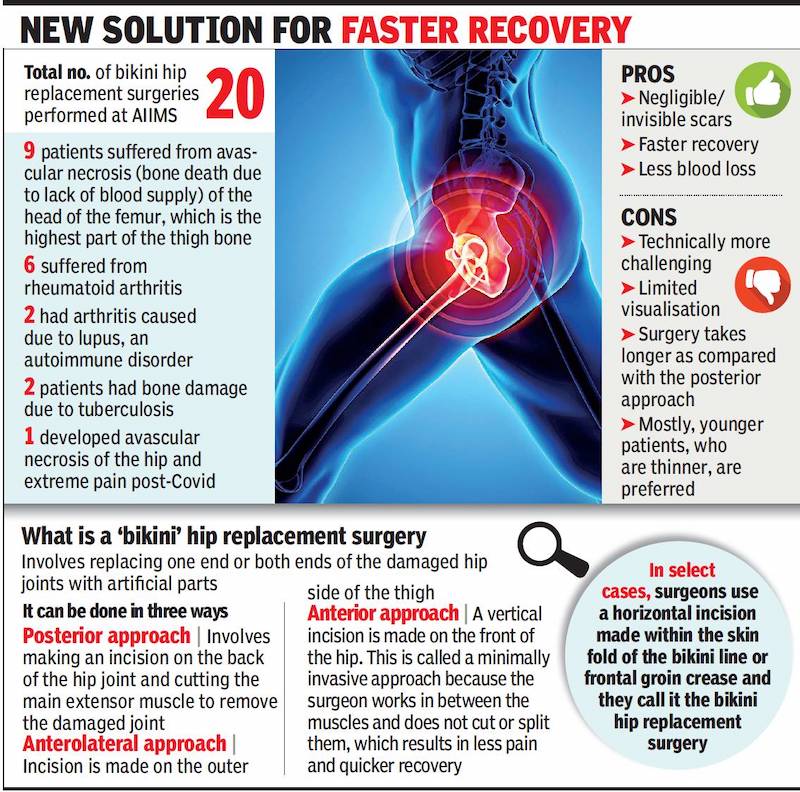
From: DurgeshNandan Jha, August 27, 2021: The Times of India
At least 20 patients, mostly women in their late 20s and 30s, have undergone hip replacement surgery at AIIMS using a modified technique in which the incision is made within the skin fold of the bikini line or the frontal groin crease. The surgery is often referred to as “bikini hip replacement surgery”.
Dr Rajesh Malhotra, professor and head of orthopaedics at AIIMS, told TOI that unlike the conventional approach for conducting hip replacement, which leaves behind a noticeable scar, the modified technique is done in a manner that few can tell surgery has been done even if the patient wears a bikini.
“Very few centres in the world do this surgery. It’s challenging and takes longer than usual, but we decided to adopt it to help young women who are hesitant to undergo the procedure for fear of the residual scar,” added Malhotra. There are three main approaches for a hip replacement surgery. In the posterior approach, the surgeon makes an incision on the back of the hip joint and cuts the gluteus maximus muscle to remove the damaged joint and replaces it with artificial parts. In the anterolateral approach, the incision is made on the outer side of the thigh. In the anterior approach, a vertical incision is made on the front of the hip to replace the joints without cutting or splitting the muscles.
The bikini surgery is a modified version of the anterior approach where the surgeons make a horizontal incision along the bikini line to ensure minimal scar. Further, special cosmetic stitches are used to minimise the noticeability of the scar.
Malhotra said the operation through the bikini incision, which is only 6-8cm in width, was more challenging than the other approaches because the field of vision and operation was less. “It needs a lot of experience and the right selection of patients to succeed,” he added.
AIIMS conducted the first such surgery last year. Till date, 20 surgeries have been performed. Nine patients suffered from avascular necrosis of the head of the femur, six patients had a history of damage to the hip joints due to rheumatoid arthritis, two others suffered from arthritis caused due to lupus and bone damage due to tuberculosis, and one patient developed avascular necrosis of the hip and extreme pain post-Covid. Most of the patients were young women.
A mini-review on the psychology of scars published in the journal Psychiatria Danubina in 2018 stated that scarring may be skin deep, but psychological impact went deeper. “The evidence is decisive; the presence of scars can result in clear markers of mental disturbance in patients with associated symptoms of depression, anger, anxiety and post-traumatic stress. A scar creates physical, emotional and psychological marks. Identity is called into question and individuals must integrate the scar with their sense of self to achieve psychological acceptance. This process causes a change of behaviour and reduced functioning, socially and psychologically, driven by the fear of being singled out. Hiding the scars relieves maladaptive behaviour and often leads to a return to normal functioning.”
Patients
2012-15: Statistics
The Times of India, Dec 07 2015
Records show 10 patients die at AIIMS daily More than 10 patients die daily on an average at the country's premier All India Institute of Medical Sciences (AIIMS), according to data provided by the health ministry . As many as 4,432 patients were reported to have died in 2012-13, 4,302 in 2013-14, 4,467 in 2014-15 and 2,802 deaths were registered at the institute till October 2015.
Health ministry officials said that the institute is catering to a large number of patients from across the country on a daily basis, who are often referred to the hospital at critical stages. AIIMS attends to more than 8,000 patients every day in its OPDs and around 400 people in the hospital's casualty wing everyday.
The maximum number of deaths were reported from departments like gastroentrology where 536, 448, 403 and 223 people died in 2012-13, 2013-14, 2014-15 and 2015-16 respectively and the Jai Prakash Narayan Trauma Center which registered 631, 624, 544 and 472 deaths during the same period.
“A large number of critical and serious patients with multiple comorbidities get admitted for treat ment at AIIMS. The institute has created high dependency units (HDUs) in several wards in a bid to reduce the mortality rate,“ said a senior official at the ministry.
He said that keeping in view the admission rate of critical patients at AIIMS, the government has approved additional 85 HDU beds and 106 ICU beds in the last three years.
The official added that in order to keep with the increasing patient load, the government has also taken steps to augment tertiary care facilities, including setting up of new AIIMSlike institutions, strengthening super specialities and setting up of the State Cancer Institutes and Tertiary Cancer Care Centers in government medical colleges.
Ranking among Medical Colleges
2015: 1st
In 2015, the All India Institute of Medical Sciences was rated the No.1 college in the category Medical Colleges in the rankings released by India Today.
2016
Damyanti Dutta , All-India institute of excellence “India Today” 11/7/2016
Research and development
Biomedical waste conversion rig
February 11, 2025: The Times of India
New Delhi : All India Institute of Medical Sciences Delhi launched an automated biomedical waste conversion rig, developed by CSIR-NIIST, Thiruvananthapuram.
The innovative waste disposal system, “Srjanam”, was officially launched by Union minister for science and technology, Dr Jitendra Singh. It offers an economical and environmentally friendly alternative to conventional biomedical waste treatment methods like incineration.
AIIMS officials said the fully automated system dissects and neutralises hazardous biomedical waste, including blood, urine, sputum, and laboratory disposables, without relying on costly and energy-intensive incinerators, making waste disposal more efficient and economical.
A unique feature of the system is its ability to impart a pleasant fragrance to otherwise foulsmelling toxic waste, ensuring safer and more manageable handling and disposal. With a capacity of 400 kg per day, the system was launched on Monday, with its initial phases currently capable of processing up to 10 kg/day of degradable medical waste. The technology will be ready for implementation soon, pending approval from the concerned authorities.
Robotic technology
Spine surgeries
DurgeshNandan Jha , Sep 22, 2019: The Times of India
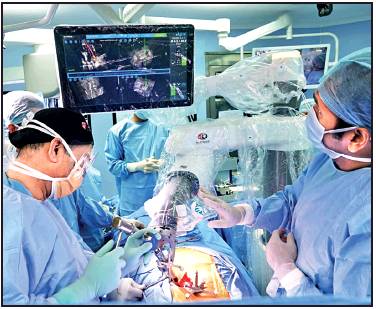
From: DurgeshNandan Jha , Sep 22, 2019: The Times of India
All India Institute of Medical Sciences (AIIMS) has acquired the latest robotic technology with inbuilt navigation and intraoperative imaging system for spine surgeries.
Dr Rajesh Malhotra, professor and head of orthopaedics at the hospital, told TOI that this would help reduce the risk of damage to surrounding tissues and nerves — a rare but known complication of the surgery to fix problems involving the spine. “This integrated technology for spine surgery is available at very few centres in the world. We have spent more than Rs 20 crore to set it up at AIIMS. Poor patients requiring complex surgeries will be able to avail it for free,” he said.
Dr Malhotra said a 45-yearold woman from West Bengal, suffering from spondylolisthesis — displacement of the lowest of the lumbar spine’s five vertebrae L5-S1 — is the first patient to have undergone spine surgery using the new technology at AIIMS. “She is doing fine. We plan to discharge her soon,” the doctor said.
According to Dr Bhavuk Garg, spine surgeon at AIIMS, surgery using the new technology is done in multiple steps. First, the imaging of the area to be operated is done using the o-arm2 — an intraoperative imaging system — and the surgeon plans how to put the screws and rods to fix the spine. Then, the image is fed into the robot, which shows the path to put the screws and rods accurately.
“Conventionally, such surgeries involve repeat Xray that leads to the patient being exposed to higher dosage of radiation. But in this case, imaging is done only once and the robotic system guides the doctor to put the screws and rods — needed to fix the spine — in the exact position on a real-time basis. This reduces the risk of intraoperative complications significantly,” Dr Garg said.
For the patients, surgery using robotic technology means smaller incision, less bleeding, reduced risk of complications and faster recovery. The doctors said spinal fixation using special screws is required for most patients suffering from spinal instability due to fracture, injury, tubercular infection and shift in spine because of ageing, among other factors. If the screw is malpositioned, there is risk of damage to the nerves, paralysis, and the screws can get loose and even migrate, they added.
Turnover of doctors
2022 to 2024
DurgeshNandan Jha, August 13, 2025: The Times of India
New Delhi: There is an exodus of doctors from All India Institute of Medical Sciences (AIIMS) across the country, with as many as 429 resigning from 20 institutes from 2022 to 2024, data shared by the govt with Parliament has revealed. The govt was responding to a question on doctors leaving AIIMS for private jobs.
The data showed the maximum number of doctors — 52 — resigned from AIIMS Delhi, which is the parent institution and the most prestigious of all AIIMS. It was followed by 38 resignations at AIIMS Rishikesh, 35 at AIIMS Raipur, 32 at AIIMS Bilaspur and 30 at AIIMS Mangalagiri. The resignations have come at a time when most AIIMS are struggling with a faculty/doctor crisis.
1 of every 3 faculty posts vacant across 20 AIIMS
Nearly one out of every three faculty positions was lying vacant across all 20 AIIMS, including Delhi AIIMS, the data showed. Recently, the govt told Parliament in response to another question that provision has been made for hiring on contract basis of retired faculty members — from Institutes of National Importance and govt medical colleges — at the level of professor, additional professor and associate professor in new AIIMS, up to 70 years.
In addition to this, the govt said, a visiting faculty scheme has been formulated to allow professors, additional professors and associate professors who are holding academic positions in govt institutions within India or academic institutions outside India, to be visiting faculty in new AIIMS for teaching purposes. However, doctors say further action is needed to stop the brain drain.
AIIMS Delhi has 1,306 sanctioned faculty positions. Of these, 462 (35%) are vacant. AIIMS Bhopal has 71 (23%) vacant faculty positions, while AIIMS Bhubaneswar has 103 (31%) vacant positions. The percentage of vacant faculty positions in other AIIMS also ranges between 20% and 35%.
Many non-faculty positions, including those of nurses, OT technicians and other crucial staff are also lying vacant.
“ over the last few years, focus has shifted towards improving the services and often we receive complaints about the lack of ‘protected time’ to carry out research, which is an important reason for the brain drain,” a senior doctor from AIIMS who recently joined the private sector said.
The senior doctor added that salaries in the private sector are four to 10 times the salary offered at AIIMS.
Bhim Rao Institute Rotary Cancer Hospital (IRCH)
2017: Reeling Under Patient Load
DurgeshNandan Jha, ’Cancer Centre Reeling Under Patient Load’, Jan 14 2017, The Times of India
Waiting time for chemo session at AIIMS: `Infinite’
The number of cancer patients admitted every year: 36,000. The number of beds available for chemotherapy: 36. While not every cancer patient admitted would require chemotherapy , the disparity explains why the wait for a chemo session could be “infinite“ at AIIMS which houses one of India's top cancer centres, the Bhim Rao Institute Rotary Cancer Hospital (IRCH).
A recent review conducted by the institute says the cancer centre is crumbling under the load of patients since their numbers have only grown while infrastructure has not. The AIIMS report says patients seeking one to two week-long chemotherapy have to wait “infinitely“ for their turn. Those undergoing three-week-long chemotherapy often miss their dates due to unavailability of beds. The crisis does not end here. The IRCH does not have a dedicated MRI facility so patients have to queue up with the rest at AIIMS. So they could end up waiting up to a year or more for the crucial diagnostic test. Should surgery be in order, they could be waiting for one to three months.
More than 1.33 lakh cancer patients visit AIIMS every year and around 36,000 are admitted. The institute is now pin ning its hopes on the Na tional Cancer Institute (NCI) coming up at Jhajjar.“There is no space left for expansion of infrastructure at IRCH and hence they are working overtime to complete the 710-bedded cancer facility in Jhajjar to handle the constantly increasing patient burden,“ said V Sriniwas, deputy director (administration), told TOI. “NCI is projected to handle 5.19 lakh patients on OPD basis and 1.41 lakh indoor patients annually once it is fully operational.“
IRCH began functioning in 1983-84 with 35 beds on two floors. At present, it has 182 beds, of which only six are ICU beds, say doctors. “There are 30 beds for chemotherapy on daycare basis,“ Sriniwas added, explaining the “infinitely long“ waiting for chemotherapy . IRCH has only three functional operation theatres and two PET CT scan machines. Cancer patients from across the country come to Delhi for treatment but, health experts point out, barring AIIMS and the newly opened Delhi State Cancer Institute (DSCI), no public sector hospital has an efficient cancer facility. “Poor people cannot afford private treatment for a disease like cancer which can cost anywhere between Rs 5 lakh and Rs 40 lakh,“ said an oncologist.
Top officials said NCI, which will be run by AIIMS, will have 25 OTs and a reasonable number of PET CT and MRI machines. “The 710-bedded cancer facility in Jhajjar is projected to handle 5.19 lakh patients on OPD basis and 1.41 lakh indoor patients annually once it is fully operational. It will be headed by Dr G K Rath,“ Sriniwas said.
India requires at least 1,300 radiotherapy units but has only around 750, said Dr P K Julka, medical oncologist at Max Super Specialty Hospital, Saket. Most of the machines, he added, are in the private sector hospitals. Delhi has around a dozen radiotherapy units, of which four are in government-run hospitals -AIIMS, Safdarjung, Lok Nayak and DSCI. Safdarjung Hospital, sources said, does not have a simulator or treatment planning system (TPS) for precise administration of dosage and has been using Cobalt-60 machines for radiotherapy services when most hospitals have switched to newer technologies such as linear accelerators.
Oncologists say that infrastructure for cancer treatment needs to be scaled up rapidly . “In 1977, when I worked at Lok Nayak Hospital, it had one Cobalt 60 machine. That hasn't changed in 38 years although the number of patients has multiplied,“ said an oncologist.
Why AIIMS is the best
Its edge, as in 2016
Damayanti Dutta , All-India institute of excellence “India Today” 11/7/2016
Conceptions of excellence at AIIMS
Dr Anna Ruddock’s 2021 critique
Oct 2, 2021: The Times of India
What has Covid shown us about the path we have chosen in healthcare and what could AIIMS have done differently?
The pandemic is a moment of reckoning for India with its legacy of neglect of public health and healthcare. What does this moment ask for from medical education, and of AIIMS, mandated to set national standards? I suggest that what is needed is at least an interrogation of prevailing concepts of excellence. And what’s the role of the doctor in society? And how is that imparted to students? A single institution cannot be expected to change the medical culture of an entire country even if the institution was mandated to do just that. But the production and the reaffirmation of narrow norms and conceptions of excellence at AIIMS adds to stifle the potential of the MBBS programme and its students, and with that the transformative impact that some of them could have on Indian health and medicine. A reenvisaging of the purpose of undergraduate education at AIIMS has the potential to make graduating from India’s most prestigious medical college more meaningful. It could become an institution as exceptional in practice as in imagination.
Why do you urge the inclusion of social sciences in AIIMS medical curriculum?
Section 14 of the AIIMS Act provides for inclusion of humanities in the MBBS curriculum but it has never been introduced. Integrating humanities and social sciences in the broadest possible terms creates a space that doesn’t currently exist for interrogating rather than naturalising social inequalities and crucially for self-reflection among students and faculty on the role of the doctor in society. At present, there is just no space for that.
The book talks of ranks feeding into the meritocracy obsession in AIIMS. How does caste or reservation fit in?
Rank is critical. It probably starts in school and by the time they get to AIIMS, everybody is well aware of their ranks — their ranks in school, in the coaching institute, in the entrance exam… I was really struck by what is the function of a number like that on one’s subjectivity, one’s sense of self.
In AIIMS or IIT entrance exams, results are calculated to seven decimal places and you have to go through hundreds or thousands of results before you really start seeing a general divergence in terms of score, and tie-breakers are used to do this false differentiation in order to create rank. So, ranks create heterogeneity, they create difference where there is actually sameness. In this scenario, merit is acquainted with upper casteness by virtue of the top ranks being associated with the general category. Often, general category students would say they have no idea of who is in which category. But students in reserved category would say entrance exam results are broadcast and so your identity is attached to you in a way that it isn’t if you were in the general category. It is upper caste privilege to say that I have a casteless worldview or that caste is not important. It is the same as white people saying “I am post racial. I don’t see colour.” This is also what allows for this narrative that affirmative action is regressive. It allows upper caste students to say why are you pulling us back into this castebased world because we had transcended that, which we know you hadn’t. You just worked around it to be invisible to you.
Why do so few AIIMSonians engage with rural healthcare?
One of the first things that trainee doctors would say is how much they would really like to work in this kind of practice (rural practice) immediately followed by why it’s just not possible. Inevitably, the common narrative is around inadequate infrastructure beyond the city being an impediment to practice. We have to have sympathy because part of that is based on truth. Why should people go to places where they don’t feel safe or where they don’t have equipment? And that goes back to this whole big question of why public healthcare has never been a political priority in India since independence, how the concept of public healthcare never took root and we still see the consequences of that.
You quote a faculty member as saying, “AIIMS killed the GP”. Could you elaborate?
We have people coming to AIIMS, particularly from across north India, in search of what is sometimes primary, sometimes secondary care. When he said AIIMS killed the GP, he meant that despite it being clear every day at AIIMS that people need more access to competent and affordable general care, there has never been an effort in AIIMS to instill in students the value of general practice. These young people are given a clear idea of what is prestigious and what is not. And that is the preoccupation of the AIIMS system, to maintain this aura of prestige.
The toughest academic institute in India to join
Rema Nagarajan, Oct 6, 2021: The Times of India
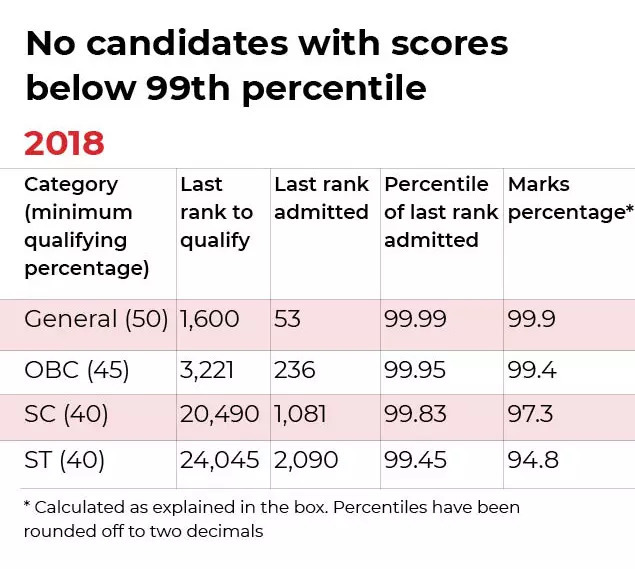
From: Rema Nagarajan, Oct 6, 2021: The Times of India
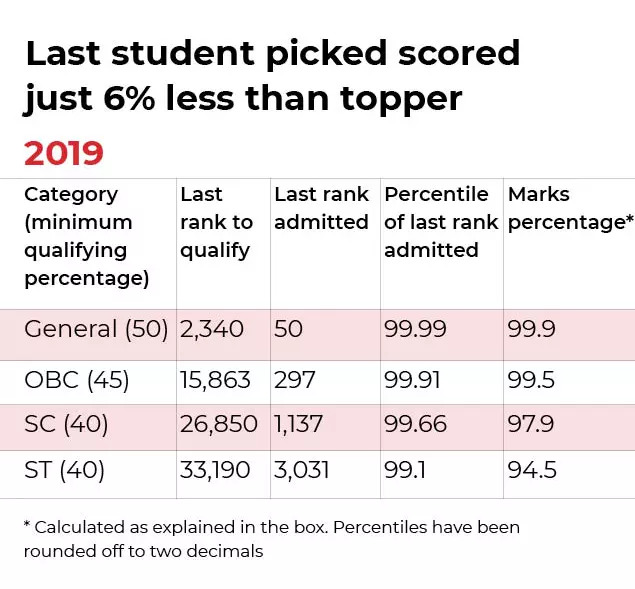
From: Rema Nagarajan, Oct 6, 2021: The Times of India
Here's proof of how competitive it is to gain admission to the All India Institute of Medical Sciences (AIIMS) in Delhi. A look at the actual scores in the entrance exam of those who got admission to the premier institute showed that they differed very little, no matter which category the students came from – General, Other Backward Class (OBC), Scheduled Caste (SC) or Scheduled Tribe (ST).
While the ranks give an impression of huge differences between admitted students from various categories, their percentile scores vary by less than one and even the absolute marks differ by less than six percentage points between the topper and the last student selected.
In fact, not only were there no candidates with scores below 99th percentile among those who got admission, even their final percentage scores were well above 90% no matter which category they belonged to, an analysis done by TOI shows.
Several tie-breaker scores used to assign ranks
For instance, in 2018 while over 3.7 lakh appeared for the exam, the lowest selected rank, which was from the scheduled tribe (ST) category, was 2,090 with a percentile score of 99.4 though the qualifying percentile level was 93.6 for tribals.
The competition is so close that several tie-breaker scores have to be used to assign ranks. Ties — those with equal overall percentiles — were resolved using percentiles in the biology section of the paper followed by chemistry, physics and finally the candidate’s date of birth, with older candidates getting ranked higher.
The lowest selected rank from the SC category was 1081 with a percentile score of 99.8, again well over the qualifying level of 40% marks equivalent to 93.6 percentile. The lowest selected rank from the OBC category was 236 equivalent to 99.9 percentile, against a qualifying level of 45%, equivalent to 97 percentile. For the general category, the qualifying level was 50% equivalent to 98.8 percentile.
In 2019 too, calculations show, there was a difference of less than six percentage points in the overall scores of the first rank and the last rank (3,000) that got admitted. The marks are not publicly announced. (More on how we arrived at the marks in the box at the end of the story.)
Anthropologist Anna Ruddock notes in her book on AIIMS-Delhi called ‘Special Treatment’ that the ranking system acts as a management tool, suggesting a legitimate differentiation in achievement that actually disguises the homogeneity of marks among top-ranked students and ends up implying that OBC, SC, and ST candidates who score lower than the GC cut-off lack the necessary aptitude to study at AIIMS.
“Among those admitted in AIIMS-Delhi, there is hardly any difference between those from different categories because the OBC, SC and ST candidates selected represent a small proportion that has access to facilities and resources to be able to get in. The National SC/ST commission should demand anonymised data on admission into all such institutes and analyse it so that informed policies could be made on how to ensure inclusion of the most deprived within categories and across geographies,” said an AIIMS faculty member.
Over the years, there have been cases of students from the reserved category committing suicide in AIIMS, Delhi, allegedly because of stigmatisation. The institute has also in the past been one of the hubs of anti-reservation movements like Youth for Equality. The findings of this analysis raise important questions about how much of this has been driven by perceptions not grounded in facts.
How did TOI estimate marks?
How did we arrive at the marks? We looked at the lowest qualifying percentage (40%) and the rank at which this is reached. This was 24,045 in 2018 and 33,190 in 2019. Assuming the topper got 100%, we can work out the average gap between successive ranks.
That works out to 0.0025 percentage points in 2018 and 0.0018 percentage points in 2019. For any rank, you can then work out how much lower than 100 it would be assuming the gap between successive ranks is more or less uniform. If the topper actually got less than 100%, the gap between him or her and the last rank to get in would be smaller.
On the other hand, marks are more spaced out at the top of the rankings, that gap could be a little wider. But in either case, the difference would not be huge and so these calculations give a good ballpark estimate of marks.
